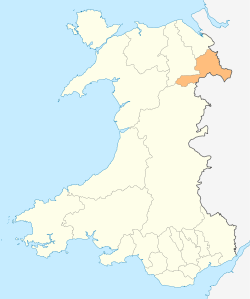Glyn Ceiriog
| Llansanffraid Glyn Ceiriog | |
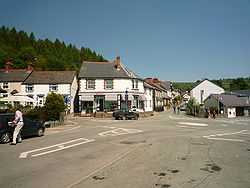 Glyn Ceiriog |
|
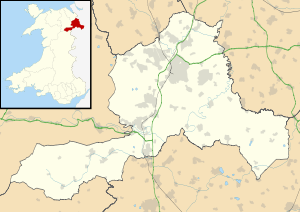 Llansanffraid Glyn Ceiriog |
|
| Population | 1,086 [1] |
|---|---|
| Language | British English |
| Welsh (48.3% of population)[2] | |
| OS grid reference | SJ2038 |
| Principal area | Wrexham |
| Ceremonial county | Clwyd |
| Country | Wales |
| Sovereign state | United Kingdom |
| Post town | LLANGOLLEN |
| Postcode district | LL20 |
| Dialling code | 01691 |
| Police | North Wales |
| Fire | North Wales |
| Ambulance | Welsh |
| EU Parliament | Wales |
| UK Parliament | Clwyd South |
| Welsh Assembly | Clwyd South National Assembly for Wales constituency |
| Website | http://www.glynceiriog.org.uk |
Coordinates: 52°56′16″N 3°10′59″W / 52.937685°N 3.18305°W
Llansanffraid Glyn Ceiriog, or simply Glyn Ceiriog, is a local government community in Wrexham County Borough in Wales.
Glyn Ceiriog is a former slate mining village in Wrexham County Borough, in Wales. It lies on the River Ceiriog and B4500 road, five miles (8km) west of Chirk and three miles (6km) south of Llangollen in the Ceiriog Valley, Clwyd South National Assembly for Wales constituency and Clwyd South parliamentary constituency.
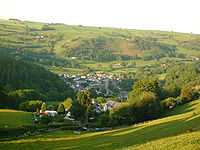
Geography and administration
Civic history
Glyn Ceiriog has historically been administered as the parish and civil parish of Llansanffraid Glyn Ceiriog, which can be translated to the "Saint Ffraid's in the Ceiriog Valley". From 1889 until 1974, Glyn Ceiriog was governed by the then administrative county of Denbighshire, which was divided into various rural districts. From 1895 to 1935, Glyn Ceiriog was in the Chirk Rural District, which merged in 1935 with Llansilin Rural District to form the Ceiriog Rural District. Glyn Ceiriog was in the Ceiriog Rural District from 1935 to 1974.
In 1974, Denbighshire was abolished as an administrative county, and Glyn Ceiriog was incorporated into the Glyndŵr District of the new county of Clwyd. Clwyd and Glyndŵr District were dissolved in 1996, and Glyn Ceiriog became a part of the new unitary authority of Wrexham County Borough, in which it remains to the present day.
Political representation
Today, Glyn Ceiriog is administered within Wrexham County Borough Council, a unitary authority created in 1996. Glyn Ceiriog is in the Ceiriog Valley ward, and has an Independent councillor.
Since 1999, Glyn Ceiriog has been represented at the National Assembly for Wales by Karen Sinclair, the Labour Party Assembly Member for Clwyd South National Assembly for Wales constituency.
Since 1997, Glyn Ceiriog has been represented at the Parliament of the United Kingdom by Martyn Jones, the Labour Party Member of Parliament for Clwyd South parliamentary constituency.
Physical geography/Geology
Glyn Ceiriog is located in the Ceiriog Valley, a valley created by the River Ceiriog. Geologically, the area has Ordovician and Silurian strata. The soil is thin and peaty.
Village Resources
Glyn Ceiriog being the principal village for the Ceiriog Valley, it is home to many of the Valley’s resources,
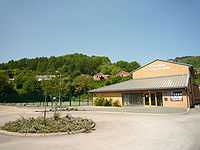
• Village Post Office
• Cross Stores Village Shop
• Glyn Valley Hotel
• The Oak Y Dderwen
www.ydderwen.com
• Canolfan Ceiriog Centre
• Springhill Farm Equestrian Centre
• Valley Doctors Surgery
• Valley Pharmacy
• Christian Centre
• Ceiriog Memorial Hall
• Llansanffraid Church
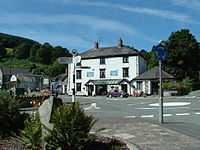
Industry and Transport
Glyn Ceiriog was once the home of extensive slate quarries and the Glyn Valley Tramway was built to take the slate to a wharf on the Shropshire Union Canal and later to interchange sidings with the Great Western Railway line from Chester to Shrewsbury.
Bus services are provided by Bryn Melyn, a subsidiary of GHA Coaches. Services operate to Llangollen via Chirk and to Llanarmon Dyffryn Ceiriog on service 64. Infrequent services on route 65 connect the village to Wrexham via Ruabon.
Rail services are available from Chirk, 5 miles away.
Plas Nantyr
Four miles west of Glyn Ceiriog is the country house and estate of Plas Nantyr. It forms part of the ancient manor of Cynlaeth Owen which Owain Glyndwr inherited from his father in the late 14th century. In the 19th century, the estate was owned by Mr Tyrwhitt, a barrister and the Recorder of Chester. Following Mr Tyrwhitt's death in 1836 his family emigrated to Canada and named the place where they settled Nantyr. At his death the Estate was sold to the Myddleton-Biddulphs of Chirk Castle, from whom it was bought by Sir Thomas Storey in 1892. [3]
Notable residents
A number of Welsh literary figures have lived in or near Glyn Ceiriog in the past. The 15th century Welsh poet Guto'r Glyn (1435 - 1493) is associated with Glyn Ceiriog. The 17th century Welsh poet Huw Morus (Eos Ceiriog) (1622 - 1709) was born, and lived, near Glyn Ceiriog. The 19th century Eisteddfod-winning poet and lexographer, Rev. Robert Elis (Cynddelw) (1812 - 1875) was a Baptist minister at Glyn Ceiriog Independent Welsh Baptist Chapel, Seion, from 1838-1840. The Welsh novelist Islwyn Ffowc Elis spent most of his childhood on a farm near Glyn Ceiriog, although he was born in Wrexham. Additionally, Lancelot Hogben an experimental zoologist and medical statistician, lived there from the late 1950s until his death.
Bibliography
- Dewi Parry Jones & Robert Owen Jones, "100 Years in the Valley - Y Glyn a Fu" (1998)
- Dewi Parry Jones & Robert Owen Jones, "100 Years in the Valley Volume II - Y Glyn a Fu" (1999)
References
- ↑ Census, 2001 http://neighbourhood.statistics.gov.uk/
- ↑ 48.3% of persons aged 3 years or over living in Wrexham 019B (Super Output Area Lower Layer) said they understood Welsh in the 2001 Census http://nationalstatistics.gov.uk
- ↑ "Plas Nantyr". Savills.
External links
- Glyn Ceiriog's Community Site
- Glyn Ceiriog's Community News Site
- The Chirk and Ceiriog Valley Partnership
- The Glyn Valley Tramway
| ||||||||||||||||||||||||||||||||||||
